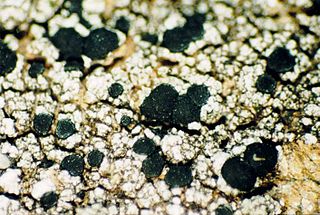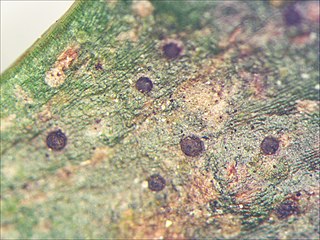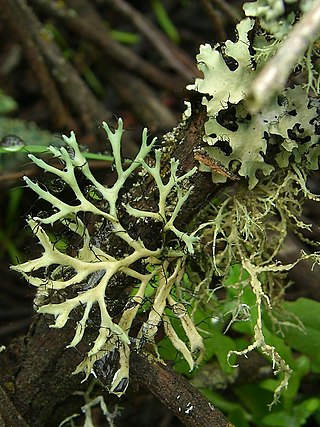
The Lecanoraceae are a family of lichenized fungi in the order Lecanorales. Species of this family have a widespread distribution.

Cliostomum is a genus of lichenized fungi in the family Ramalinaceae. It has about 25 species.
Physcidia is a genus of lichen-forming fungi in the family Ramalinaceae. The genus was circumscribed in 1862 by American lichenologist Edward Tuckerman.

Tapellaria is a genus of leaf-dwelling lichens in the family Pilocarpaceae. The genus was circumscribed by lichenologist Johannes Müller Argoviensis in 1890, with Tapellaria herpetospora assigned as the type species.

Pyxine is a genus of foliose lichens in the family Caliciaceae. The genus has a widespread distribution in tropical regions.

Lecanactis is a genus of crustose lichens, commonly called old wood rimmed lichen. The genus was circumscribed in 1855 by German lichenologist Gustav Wilhelm Körber, who assigned Lecanactis abietina as the type species.
Punctonora is a genus of lichen-forming fungi in the family Lecanoraceae. The genus was circumscribed in 1997 by lichenologist André Aptroot, with Punctonora nigropulvinata assigned as the type species. A second species was added to the genus in 2018.

Vainionora is a genus of lichen in the family Lecanoraceae. The genus, which was circumscribed in 1991 by German lichenologist Klaus Kalb, honours the Finnish lichenologist Edvard Vainio, who described the type species as Lecanora pallidostraminea in 1890.

The Lecideaceae are a family of lichens in the order Lecideales.

Chrysothrix is a genus of lichen-forming fungi in the family Chrysothricaceae. They are commonly called gold dust lichens or sulfur dust lichens, because they are bright yellow to greenish-yellow, sometimes flecked with orange, and composed entirely of powdery soredia. Apothecia are never present in North American specimens.

Coenogonium is a genus of filamentous lichens in the monotypic family Coenogoniaceae. It has about 90 species. Most species are leaf-dwelling or grow on bark, although a few are known to grow on rocks under certain conditions, and some are restricted to growth on termite nests. The genus was circumscribed in 1820 by German naturalist Christian Gottfried Ehrenberg.
Eugeniella is a genus of mostly leaf-dwelling (foliicolous) lichens in the family Pilocarpaceae. It contains 13 species. The genus was circumscribed in 2008 by lichenologists Robert Lücking, Emmanuël Sérusiaux, and Klaus Kalb, with Eugeniella psychotriae assigned as the type species. This lichen was originally called Patellaria psychotriae by Johannes Müller Argoviensis in 1881. The seven species that were initially included in the genus had previously been placed in the genera Bacidia and Byssoloma. Several newly identified species from Australasia and Central and South America were later added. Most of the species grow on leaves, although four of the Australasian species grow on bark.

Polyblastidium is a genus of foliose lichens in the family Physciaceae. It has 18 species. The genus was circumscribed by German lichenologist Klaus Kalb in 2015, with Polyblastidium japonicum assigned as the type species. Polyblastidium is similar in morphology to Heterodermia, but its lower surface is cobweb-like in structure (arachnoid), and its ascospores are mostly 1-septate with 1 to 3 sporoblastidia. It is this latter feature that is referenced in the genus name Polyblastidium. The genus contains several species that were formerly classified in the genus Anaptychia.

Leucodermia is a genus of lichen-forming fungi in the family Physciaceae.

Loxospora is a genus of lichen-forming fungi in the family Sarrameanaceae. It has 13 species. The genus was circumscribed by Italian lichenologist Abramo Bartolommeo Massalongo in 1852, with Loxospora elatina assigned as the type species. This crustose lichen was originally named Lecanora elatina by Erik Acharius in 1810.
Pseudoparmelia kalbiana is a species of foliose lichen in the family Parmeliaceae. It is found in South America.
Kalbographa is a genus of lichen-forming fungi in the family Graphidaceae. The genus was circumscribed in 2007 by lichenologist Robert Lücking with Kalbographa caracasana assigned as the type species. The genus name honours German lichenologist Klaus Kalb.
Halegrapha is a genus of lichen-forming fungi in the family Graphidaceae. It has nine species. The genus was circumscribed in 2011 by Eimy Rivas Plata and Robert Lücking, with Halegrapha chimaera assigned as the type species. The generic name honors American lichenologist Mason Hale.

Robert Lücking is a German lichenologist. He earned his master's and PhD from the University of Ulm, focusing on the taxonomy, ecology, and biodiversity of foliicolous lichens. He has received numerous awards for his work, including the Mason E. Hale Award for his doctoral thesis, the Augustin Pyramus de Candolle prize for his monograph, and the Tuckerman Award twice for his publications in The Bryologist. Since 2015, he has been serving as the curator of lichens, fungi, and bryophytes at the Berlin Botanical Garden and Botanical Museum, and several lichen species and a genus have been named in his honour.
Diaphorographis is a genus of lichen-forming fungi in the family Graphidaceae. It has two species. The genus was circumscribed in 2009 by lichenologists Alan W. Archer and Klaus Kalb, with D. queenslandica as the type species. The genus is distinguished from Graphis by the I– (iodine-negative) ascospores, and from Carbacanthographis) by the absence of periphysoids. Collectively, the genus is found in northern Queensland, New Caledonia, and the Solomon Islands. Although the genus was originally reported to not contain any lichen products, a later reexamination of the type species revealed the presence of protocetraric acid.












